London, the UK’s vibrant and multicultural capital, greets you with iconic landmarks like Big Ben and St. Paul’s Cathedral, offering a rich tapestry of history while constantly pushing the boundaries of art and culture.
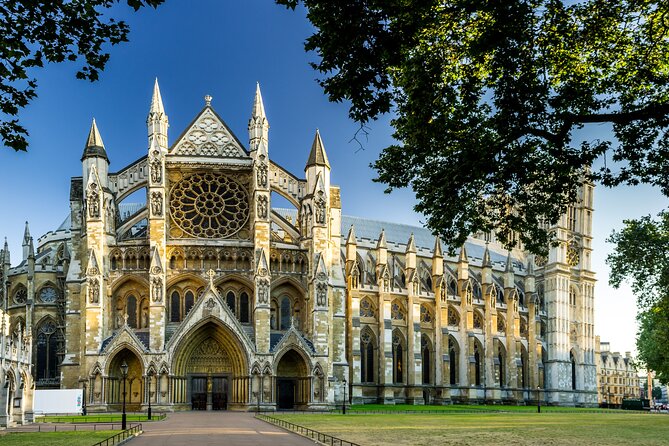
A stunning blend of architectural styles, Westminster Abbey is hailed as the finest example of Early English Gothic. But it’s more than a beautiful structure – it’s an active place of worship and the setting for countless historic moments. Although never a cathedral (it isn’t the seat of a bishop), it holds the special title of a “royal peculiar”, meaning it’s under the direct jurisdiction of the Crown.
At the Abbey’s heart lies the beautifully tiled sanctuary, the ceremonial stage for coronations, royal weddings, and funerals. The ornate High Altar, designed by George Gilbert Scott in 1873, stands above the Cosmati Pavement, a breathtaking 1268 mosaic of stone and glass symbolizing the universe and its end (legend has it the world ends after 19,683 years). Nearby, at the entrance to the Chapel of St John the Baptist, is a delicate alabaster sculpture of the Virgin and Child, added in 1971.
The holiest part of the Abbey is the shrine of St Edward the Confessor, hidden behind the High Altar. It’s accessible only via guided tours to protect the fragile 13th-century flooring. Edward, canonized long after his death, founded the Abbey and saw its original consecration just before he died in 1066. King Henry III later added the present shrine, adorned with Cosmati mosaics – a site where pilgrims once prayed for healing (and occasionally chipped off bits as souvenirs).
The Quire (choir), with its vibrant blue, gold, and red Victorian Gothic design and black-and-white tiled floor, dates to the 1800s and now hosts performances by the Choir of Westminster Abbey, made up of 30 boys and 12 adult singers.
At the eastern end is Henry VII’s Lady Chapel, a masterpiece of Perpendicular Gothic architecture, boasting an elaborate fan-vaulted ceiling and soaring stained-glass windows.
Opened in 2018, the Queen’s Diamond Jubilee Galleries sit in the medieval triforium above the nave. This museum space houses remarkable artifacts including royal death masks, wax effigies, armor, stained glass, and rare manuscripts like the 1380 Litlyngton Missal. You’ll also find the Westminster Retable, England’s oldest surviving altarpiece, and even graffiti-carved coronation chairs – one used by Mary II.
Near the Tomb of the Unknown Warrior—a WWI soldier buried here in 1920—you’ll find St George’s Chapel, home to the unassuming Coronation Chair. With the exception of Mary II and William III (who used separate chairs in 1689), this has been the seat of every British monarch since the 1300s.
As you explore, you’ll encounter the final resting places of poets, scientists, and writers. In Poets’ Corner, look for the graves or memorials of Geoffrey Chaucer, Charles Dickens, Alfred Tennyson, Rudyard Kipling, and more. Scientists’ Corner, near the north aisle, includes Sir Isaac Newton, Charles Darwin, and even Stephen Hawking.
The octagonal Chapter House, dating from the 1250s, was once where monks gathered for prayers and daily duties. Nearby is what’s believed to be Britain’s oldest door, still intact since the 1050s. Don’t miss the Pyx Chamber, a 1070-era treasury where gold and silver were tested for coin-making.
Though much of the current structure dates to the 13th century, Westminster Abbey was originally founded in AD 960. Henry III began the Gothic rebuild in 1245, and the nave was completed under Richard II in 1388. The Lady Chapel followed, completed in 1516 after 13 years of work.
Since William the Conqueror’s coronation in 1066, every British monarch—except for a few unusual cases—has been crowned here. It’s the burial site for 17 monarchs, from Henry III to George II, and has hosted 16 royal weddings, including Prince William and Catherine Middleton’s in 2011.
Tickets must be booked in advance through the Abbey’s official website.
A multimedia guide is available for an extra fee.
The Abbey remains open for daily worship and individual prayer, with regular services.
Evensong takes place at 5pm on Tuesdays and 3pm on weekends.
Photography is permitted, but restrictions apply regarding location and timing.
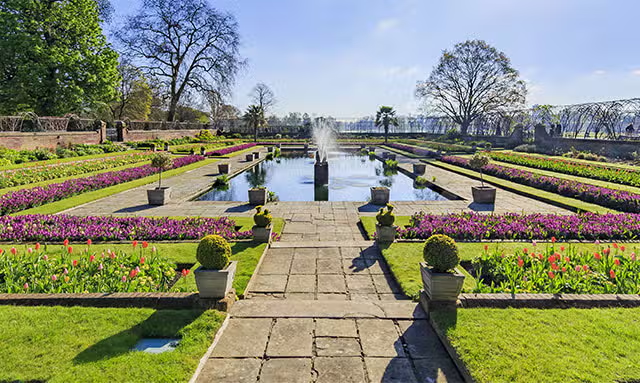
Spanning 142 hectares, Hyde Park is one of London’s most cherished green spaces, blending manicured gardens with wild grassy areas and majestic trees. More than just a peaceful retreat, the park hosts year-round concerts, public events, and is home to several remarkable landmarks.
The eastern side of the park offers open lawns that transform into a lively picnic spot on sunny days. In contrast, the western side feels more natural, with wilder grasslands and mature trees. For a burst of color and shade, visit the Rose Garden, where flowers bloom throughout the year. Nearby is the Holocaust Memorial Garden, marked by a simple stone in a tranquil grove.
Don’t miss the Serpentine lake and the Diana, Princess of Wales Memorial Fountain—two of Hyde Park’s most beloved features.
Need to relax? You can rent a deck chair anywhere in the park from March to October (prices: £1.80 for one hour, £4.80 for four, and £9 for a full day, weather permitting).
This L-shaped lake separates Hyde Park from Kensington Gardens. Once fed by the River Westbourne, the Serpentine is now a hub for both swimmers and boaters.
Swim at the Serpentine Lido (open June to September) or let kids enjoy the paddling pool.
Stay dry? Rent a pedal boat from the Serpentine Boathouse.
On weekends (and daily in peak summer), the SolarShuttle Boat runs between the Boathouse and the Diana Fountain.
Designed by Kathryn Gustafson, this unique circular fountain near the Serpentine Bridge is made of 545 Cornish granite pieces, fed by an underground chalk aquifer. Shaped like a flowing necklace or a moat without a castle, it invites visitors to walk and splash around—a favorite with children and families.
Located in the park’s northeastern corner, this historic soapbox site has hosted legendary figures like Karl Marx, George Orwell, and Vladimir Lenin.
Every Sunday, people still gather here to speak freely—a tradition stemming from an 1872 law that allows demonstrations without police permission. The corner is also linked to the nearby Tyburn gallows, where condemned prisoners once addressed the crowd before execution.
These two leading contemporary art galleries are a must-visit:
The Serpentine Gallery, south of the lake in a 1930s former tea house, has exhibited works by Damien Hirst, Louise Bourgeois, and Jeff Koons.
The Serpentine Sackler Gallery, across the Serpentine Bridge, is housed in a historic 1805 gunpowder depot, reimagined with a dramatic extension by Zaha Hadid.
Each summer, a renowned architect debuts a Summer Pavilion near the galleries, open from June to October, alongside a full schedule of exhibitions, talks, and readings.
Hyde Park was originally church land, taken by Henry VIII in 1536 and used as a royal hunting ground. Over the centuries, it became the backdrop for duels, executions, horse races, and in 1851, the site of the Great Exhibition. During WWII, it served a more humble purpose—as a giant potato field.
Looking to stay nearby?
Budget options can be found around Lancaster Gate, Queensway, and Bayswater Tube stations.
For a luxury stay, Kensington offers several high-end hotels, including:
37 Trevor Square
Knightsbridge Hotel
The Lanesborough
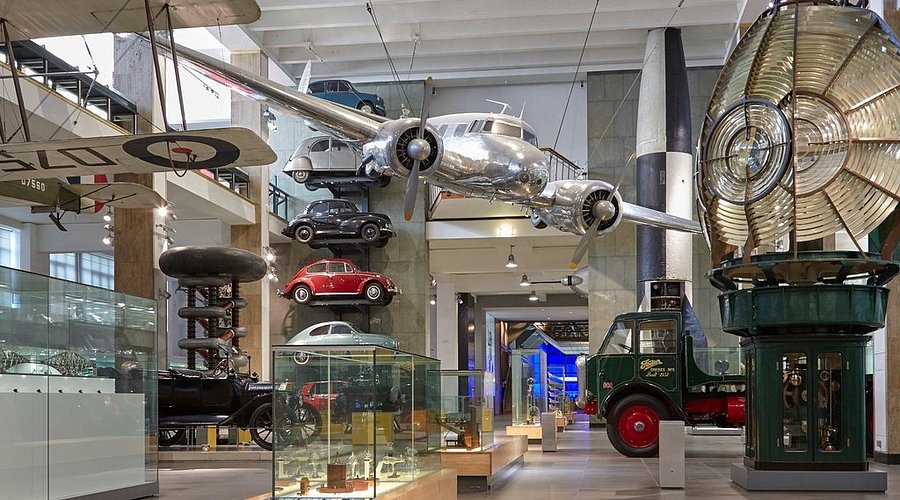
The Science Museum is one of London’s most captivating attractions, offering a journey through time, technology, and space. With interactive displays and educational exhibits, it’s a perfect destination for families and curious minds of all ages. From early inventions to futuristic discoveries, the museum nurtures a deep appreciation for how science shapes our world—and beyond.
An interactive sensory play zone for children under six, The Garden is a lively space where kids can explore water, light, sound, and construction. The water play area is especially popular, so bring a waterproof apron or spare clothes—expect lots of splashes!
This gallery is a showcase of groundbreaking inventions—from locomotives and planes to iconic cars. It offers a compelling timeline of innovation from the Industrial Revolution to the present day.
A favorite for space enthusiasts, this gallery displays real rockets and satellites, including:
A full-size replica of the Eagle lunar lander that carried Armstrong and Aldrin to the moon.
The Soyuz module that brought astronauts Tim Peake and team back to Earth in 2016.
Explore how communication has transformed the world, from the telegraph to smartphones. Notable highlights:
A wireless message from the sinking Titanic.
The first BBC radio broadcast.
A Soviet BESM-6 supercomputer.
Designed by Zaha Hadid Architects, this gallery delves into how mathematics applies to everyday life—revealing its hidden role in everything from design to navigation.
Opened in 2019, these galleries use historic and modern objects to trace the evolution of medical science. Highlights include:
The world’s first MRI machine
A prosthetic arm
Robotic surgical tools
COVID-19 vaccine vials
Ideal for young aviation fans, this gallery features:
Hot-air balloons and gliders
The Gipsy Moth airplane “Jason I”, flown by Amy Johnson to Australia in 1930
Flight simulators (additional charge):
3D Red Arrows experience
VR mission with astronaut Tim Peake
Typhoon fighter jet simulation
(Admission: £11 adults / £9 children)
This hands-on science zone is packed with interactive exhibits:
Generate sound waves
Orbit a model Earth around the sun
Launch paper planes over a wind tunnel
Build bridges using curved blocks
Experiment with pulleys and mechanics
Live science shows (some with exciting explosions!) and on-site “Explainers” make learning even more fun and accessible.
Admission: General entry is free, but advance booking is required via the museum’s website.
Timed access may apply to certain galleries like The Garden (20-minute slots).
Paid experiences: IMAX, virtual reality, Wonderlab, and flight simulators require separate tickets.
Facilities:
On-site café and snack bar
Lifts and accessible restrooms throughout
Wheelchairs available for loan

Originally built in 1703 for the Duke of Buckingham, Buckingham Palace became the monarch’s official London residence in 1837. However, King Charles III now spends most of his time at Clarence House and Highgrove in Gloucestershire, opting for a more personal approach to royal life.
When the King is at the Palace for official duties, the Royal Standard—a bold square flag in yellow, red, and blue—flies above. Otherwise, you’ll see the Union Flag.
From mid-July to September, when the King is away on summer holiday, visitors get a rare glimpse inside the Palace. You’ll need to book in advance, as tickets sell out quickly.
The self-guided audio tour begins at the Grand Hall, leading you up the dramatic Grand Staircase, a creation of King George IV in 1828. Along the way, you’ll encounter:
The Green Drawing Room, styled in Italianate design by architect John Nash
The opulent State Dining Room, filled with red damask and Regency elegance
The Blue Drawing Room, with its stunning fluted ceiling
The White Drawing Room, often used for receiving foreign dignitaries
One of the highlights is the Ballroom, which hosts a themed special exhibition each season—topics have included royal fashion, palace childhoods, and more. While the Throne Room is historically important, visitors often find it surprisingly understated.
The gardens are a peaceful retreat and an underrated part of the visit. With around 350 species of plants and flowers, lively birdsong, and lovely lake views, the garden is as regal as it is relaxing.
Guided tours of the gardens include interesting insights from the Palace’s groundskeepers and must be booked when you purchase your tickets.
Open to visitors in summer (mid-July to September) and occasionally on selected winter days (December to February)
Timed-entry tickets are essential and best reserved online
The self-guided tour takes about 2 hours
Airport-style security is in place
Large bags are not allowed
Be sure to get your ticket stamped before leaving—you’ll receive free re-entry for a year
Accessibility: The State Rooms are fully accessible, but seating is limited during the long tour. Use the restroom and grab a snack before starting, as facilities and the café are only available at the end of the tour.
Nearest Tube stations:
Green Park (Piccadilly, Victoria, Jubilee lines)
St James’s Park (District, Circle lines)
If you don’t tour the Palace, you can still witness the grandeur of the Changing of the Guard. This free 45-minute ceremony on the forecourt of Buckingham Palace features the iconic red-uniformed soldiers and a full military band as the Old Guard is replaced by the New.
Arrive at least 45 minutes early to get a good view
Expect large crowds (and plenty of selfie sticks!)
Check the schedule online, as the ceremony can be cancelled due to weather or road closures

Officially known as the Palace of Westminster, the Houses of Parliament are home to both the elected House of Commons and the appointed (or hereditary) House of Lords. This grand neo-Gothic masterpiece dates from the mid-1800s, though its roots stretch back much further. The oldest part—Westminster Hall—survived the devastating fire of 1834 and dates back to the 11th century.
A visit here is more than a sightseeing stop—it’s a deep dive into the workings of British democracy.
The Palace’s most recognizable feature is Elizabeth Tower, famously known as Big Ben. While commonly used to refer to the tower, Big Ben is actually the 13.7-tonne bell inside it, named after Benjamin Hall, the first Commissioner of Works. Restoration work has had the tower under scaffolding, but it remains a symbol of London’s skyline.
Built in 1097, Westminster Hall is the oldest surviving part of the complex. Its magnificent hammer-beam roof—added between 1393 and 1401—is the largest of its kind in Northern Europe. The hall was once the hub of royal banquets and major trials.
Historic events held here include:
The trial of William Wallace (1305)
Sir Thomas More (1535)
Guy Fawkes (1606)
King Charles I (1649)
In more recent history, the hall served as the lying-in-state site for Winston Churchill, and several monarchs.
Another surviving relic of the medieval palace is the Jewel Tower, built in 1365 to safeguard royal treasures.
Parliament consists of two chambers:
House of Commons (green benches):
The lower house, made up of 650 elected Members of Parliament (MPs), who debate and vote on legislation.
House of Lords (red benches):
The upper house, traditionally reserved for hereditary peers, but now mostly filled by appointed members. It includes life peers, bishops, and judges, totaling around 800 members.
After both houses pass a bill, it receives Royal Assent from the monarch—a ceremonial step, as the last refusal occurred in 1707.
The highlight of the parliamentary calendar is the State Opening of Parliament, held in May or June, when the monarch arrives in the gold-trimmed Irish State Coach and formally opens the new session in the House of Lords. Her crown travels separately in Queen Alexandra’s State Coach.
Currently, public tours are suspended, but virtual tours and online workshops are available.
Once in-person visits resume:
Tours typically run on Saturdays, and advance booking is essential.
Expect airport-style security checks and queues.
UK residents can request a free tour through their local MP.
Debates are open to the public when Parliament is in session.
Popular sessions like Prime Minister’s Questions (noon on Wednesdays) draw large crowds—arrive early and prepare to wait.
Not all debates are fiery; many are slow-paced and procedural.
Whether you’re admiring the Gothic architecture, walking the path of history in Westminster Hall, or watching the democratic process unfold live, the Palace of Westminster offers a fascinating window into Britain’s past and present.
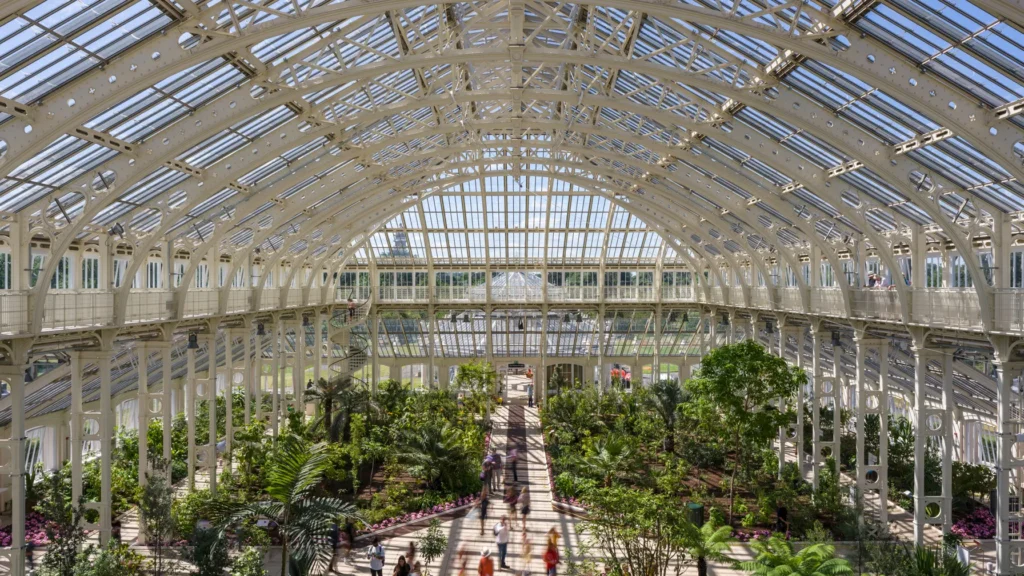
Where else in London can you admire a towering 18th-century Chinese pagoda, stroll through a Japanese gateway, and explore one of the world’s most remarkable botanical collections—all in one place? Welcome to Kew Gardens, a beloved escape for Londoners and visitors alike, known for its stunning Victorian glasshouses, peaceful landscapes, and global plant diversity.
Spanning 121 hectares, Kew is more than just a garden—it’s a world-class center for botanical research and a UNESCO World Heritage Site.
The Palm House: A magnificent steamy Victorian glasshouse built in the 19th century, filled with exotic tropical plants beneath soaring curved glass and wrought iron.
The Temperate House: The largest ornamental glasshouse in the world, showcasing rare and endangered plants from temperate zones.
Princess of Wales Conservatory: A modern marvel housing ten different climate zones.
Kew Palace: The red-brick residence of King George III, dating to 1631, once used as a royal country retreat.
The Great Pagoda: A striking ten-storey Chinese tower designed by William Chambers in 1762.
Treetop Walkway: Rise 18 meters above ground to walk among the canopy of trees—an unforgettable view from above.
The Hive: A 17-meter tall aluminum structure that glows with hundreds of LED lights, simulating the activity inside a real beehive.
The Arboretum: Covering two-thirds of Kew, this tree collection includes over 14,000 trees, from mighty redwoods to ancient pagoda trees.
Great Broad Walk Borders: At 320 meters long, this is the UK’s longest double herbaceous border, bursting with seasonal color.
Queen Charlotte’s Cottage: A quaint, thatched retreat nestled in the southwest corner, surrounded by carpets of bluebells in spring.
Children’s Garden: A massive, interactive play space for kids—spanning the size of 40 tennis courts!
Founded in 1759 by Princess Augusta, Kew Gardens began as a royal botanic garden and evolved into the most comprehensive plant collection on Earth. Its scientific mission continues today, making Kew a global hub for botanical research and conservation.
Tickets: Book online in advance. Discounts are available for families and concessions.
Getting There:
By Tube: Kew Gardens Station (5-minute walk to Victoria Gate)
By Train: Kew Bridge Station, then walk across Kew Bridge
By Boat: From Westminster to Kew Pier (April–October)
By Car: Limited parking available
Accessibility: The Kew Explorer train is a great way to see major sights in less time.
Best Time to Visit: Spring for blossoms, summer for events, and winter for the magical Christmas light trails.
Plan Ahead: Bring comfortable shoes—you could easily spend a full day here exploring.
Whether you’re a nature lover, architecture enthusiast, or curious explorer, Kew Gardens is a magical blend of horticulture, history, and heritage—an essential stop on any London itinerary.
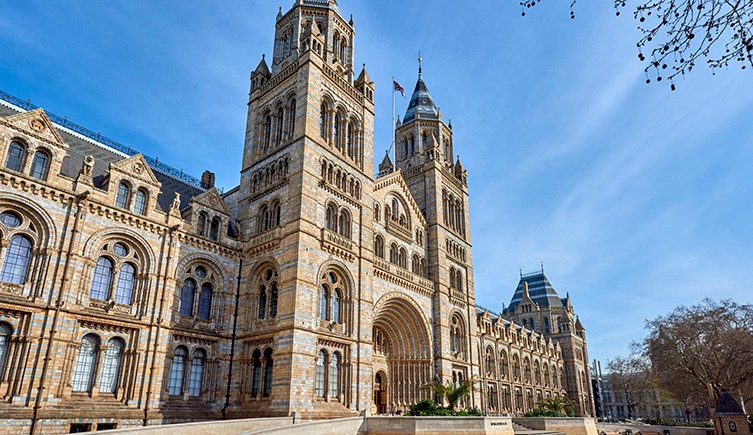
A visit to London’s Natural History Museum is an unforgettable experience for all ages. Set in a spectacular neo-Gothic building that feels like it leapt from the pages of a fairy tale, this museum combines thrilling exhibitions with architectural grandeur. While it’s designed with kids in mind, adults will find it equally captivating.
From the moment you step into Hintze Hall—a vast, cathedral-like space—you’re greeted by an enormous blue whale skeleton suspended in a dramatic dive. This centerpiece replaced the iconic diplodocus cast, “Dippy,” now touring the UK.
Dinosaurs Gallery: A must-see, especially for families. Marvel at fossils, a gigantic triceratops skull, and the show-stealing animatronic T-Rex that roars to life with startling realism.
Human Biology & Mammals Gallery: Discover how the human body works, then walk among life-size models of animals from across the globe—including a blue whale replica that fills the ceiling space.
Cadogan Gallery: Don’t miss the Treasures Exhibition, where eclectic artifacts like a chunk of moon rock and a dodo skeleton each tell a unique story.
Mineral Gallery & Vault: Admire shimmering crystals, rare minerals, and the dazzling Aurora Collection of nearly 300 colored diamonds.
Red Zone: Enter through a massive rotating Earth sculpture and explore the planet’s natural forces—volcanoes, earthquakes, and tectonic shifts.
Orange Zone: At the Darwin Centre, peek into scientific workspaces through glass walls, and explore a cocoon-like structure housing millions of plant and insect specimens.
Wildlife Garden (April to November): Step into a living exhibit of British lowland habitats, complete with wild meadows, farm gates, and a buzzing bee tree.
Ice Rink (Halloween to January): The East Lawn transforms into a magical winter setting, featuring a popular ice rink and cozy stalls serving hot drinks.
Admission: Free entry; donations encouraged. Special exhibitions (like Wildlife Photographer of the Year) require paid tickets—book early!
When to Visit:
Weekdays: Best after 2 PM when school groups leave.
Weekends: Arrive early to beat the crowds.
Entrances:
Main: Cromwell Road (can get busy)
Quieter & wheelchair-accessible: Exhibition Road and Queen’s Gate
With over five million visitors a year, the museum is one of London’s most visited attractions—deservedly so. Whether you’re fascinated by dinosaurs, dazzled by gemstones, or simply want to explore the wonders of nature, the Natural History Museum promises a memorable journey through time and science.

An enduring symbol of London’s strength and beauty, St Paul’s Cathedral is Sir Christopher Wren’s 300-year-old architectural triumph. Perched on Ludgate Hill—the city’s highest natural point—this magnificent structure has served as a place of worship for over 1,400 years, with roots even deeper in pre-Christian history. Its grand silhouette and soaring dome have become icons of resilience, especially during WWII, when the cathedral miraculously survived the Blitz.
Stepping inside and climbing to its summit rewards you with one of the most awe-inspiring views of London—a truly uplifting experience in every sense.
Rising 85 metres above the cathedral floor, the dome is a marvel of engineering and design. It comprises three parts:
An inner brick dome with a stunning painted ceiling
A structural cone that supports the weight
An outer lead dome visible on London’s skyline
Ascend the Whispering Gallery (257 steps), where even the softest sounds carry across its circular walls. Continue up 119 more steps to the Stone Gallery, then brave another 152 iron steps to reach the Golden Gallery—offering panoramic views of the London skyline that are well worth the climb.
Beneath the cathedral lies the crypt, where nearly 300 notable figures are remembered. Here rest national heroes like Admiral Lord Nelson and the Duke of Wellington. Most moving of all is the simple tomb of Sir Christopher Wren himself. His epitaph reads: “If you seek his monument, look around you.”
The current cathedral was built between 1675 and 1710 after the Great Fire of London destroyed the medieval church that once stood here. Designed in the English Baroque style, Wren’s masterpiece replaced four earlier cathedrals that dated back to 604 CE.
The dome, inspired by St Peter’s Basilica in Rome, became a beacon of hope during the Blitz of WWII when it survived a bombing raid that devastated much of the surrounding area. The nearby People of London Memorial pays tribute to the 32,000 civilians killed during the war.
Book online for discounted rates and quicker entry.
Admission includes:
✔ Cathedral floor
✔ Whispering Gallery, Stone Gallery & Golden Gallery
✔ Crypt and memorials
✔ Multimedia guides
Free guided tours (1.5 hours) run daily; sign up at the tour desk inside.
Additional paid tours offer exclusive access to hidden areas like the Geometric Staircase, Great Model, and library with stunning overhead views of the nave.
If you’re attending for worship, admission is free, though access is limited. For a moving musical experience, attend a Sunday Eucharist or Evensong featuring the cathedral choir—check the official website for timings and guest choir appearances.
WhatsApp us